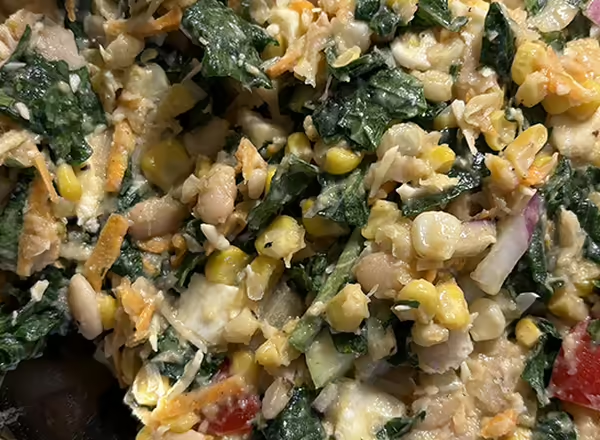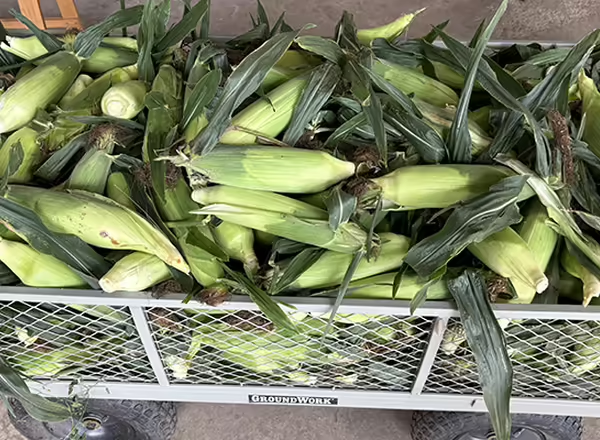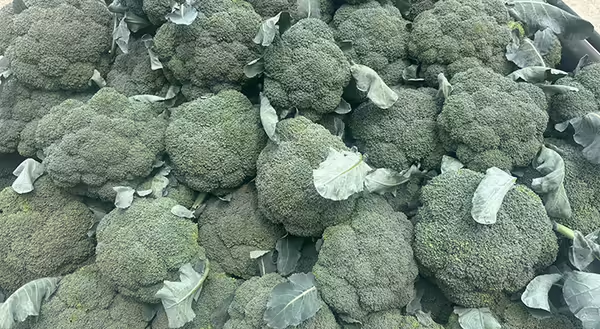
During a recent visit to the Bloomington farmers market, I saw something that stopped me in my tracks. It was a perfectly formed, large, yellow cauliflower on a farm vendor’s table. It seemed to pull me into the vendor’s booth like a magnet. Cauliflower is one of my family’s favorite vegetables to eat all year. Locally grown cauliflower is available only for a few weeks a year in Illinois… After purchasing the huge cauliflower for dinner, I had some questions for the vendor.
Cathy Troyer oversaw the market booth that day, as she does every Saturday during the Bloomington farmers market season. As I paid for my extraordinary cauliflower specimen and snapped a picture of the cauliflower “potato” salad recipe placard prominently displayed on their table, we chatted about where their farm is located, what they grow, and more.
Cathy and her husband Larry own and operate Troyer Family Gardens (TFG), based in Hudson, Illinois, just north of Bloomington, together with some of their children and many grandchildren.
Annually, TFG grows their own transplants and hanging baskets, two acres of sweetcorn, and one acre of diversified vegetable crops. Meanwhile, Larry manages cash grain acreage across McLean County, under a separate but related business entity.
During our conversation, Cathy mentioned something that caught me by surprise. “Running our vegetable garden is my retirement project!” I thought back to my days as a vegetable farm apprentice – specifically my late afternoons icing and stretching sore muscles – and wondered why anybody would want to farm vegetables commercially, in retirement.
Unfortunately, there wasn’t time to get the answer to my cauliflower question before the next interested customers wanted their own! So, we exchanged business cards, and I told her I would be in touch for an interview. Two weeks later, Cathy graciously welcomed me to the farm to learn more.
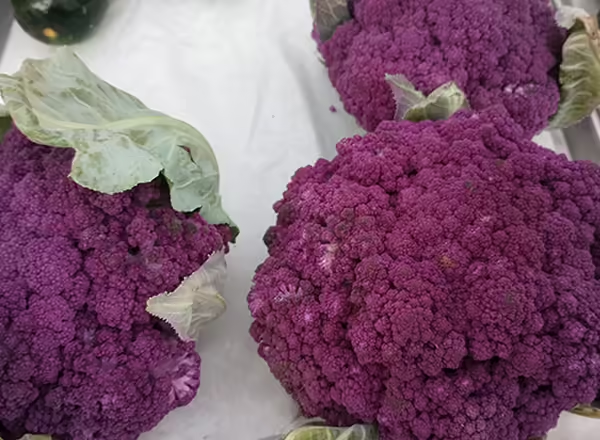
I begin most of my farmer interviews with a deep dive into their backgrounds, but we picked up right where we had left off. “What is your secret to such amazing cauliflower production here in McLean County?” I asked.
“Certainly, the weather this year until about 3 weeks ago has been near-perfect. It’s not often we’ve had the mix of sun and water that we’ve gotten here. That helps a lot. Another huge part of it is seed selection. When I’m looking for our cauliflower seed, I want a self-wrapping variety. With self-wrapping cauliflower, you can’t see the harvestable heads until they’re ready – that’s an easy visual queue. We also want good heat tolerance genetics in the seed to keep it from flowering in the field. It can get hot here in June!”
As with anything, a certain amount of crop quality is left up to luck, and Mother Nature. However, a big reason for a crop’s performance comes from soil quality and management.
“Can you tell me about your soil preparation protocol for your acre of vegetables? What does your fertility program look like?” I asked. Cathy obliged. “The whole area around our home (which is now where the vegetables are grown) used to be a dairy feedlot, so the residual fertility in this area is still very good. We are starting out every year with an excellent fertility foundation.”
Cathy continued, “Beyond that, Larry runs over all our rows with the high-speed disk after the harvest season – doing the same fall field work as with his corn and bean fields. In the spring, we apply a general (15-15-15) N-P-K plus other macros and micros to our cash grain fields right before planting. Well, that same fertility blend from FS is what our vegetable soils get as well.”
It turns out, if you fertilize cauliflower like a cash crop, it grows like one.
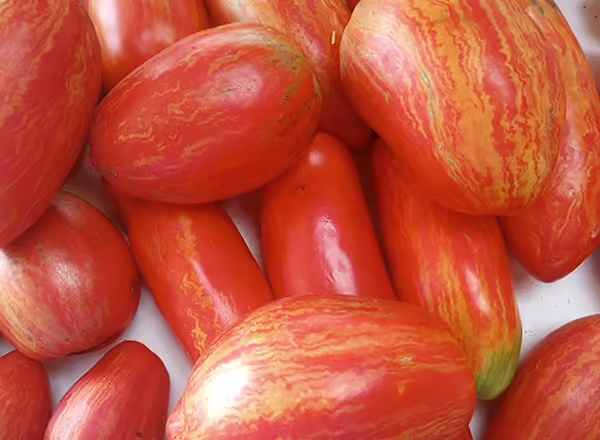
“I want to return to something you mentioned briefly,” I said. I pressed for more detail on the seed selection sourcing and protocol. I asked where Troyer Family Gardens sources their seeds, and where they fall on the hybrid vs. heirloom seed debate.
Like most diversified vegetable producers, they have their favorite seed vendors and mainly stick with them. “We buy from 3-4 different companies most years,” Cathy said. I get most of my tomato seed stock from Totally Tomatoes in Wisconsin, and then the rest is split between Harris Seeds in New York, and Johnny’s Selected Seeds in Maine.”
We talked at length about hybrids vs. heirlooms. “People get really caught up in the heirlooms thing; they’re great, don’t get me wrong. They taste good, but in commercial, for-profit vegetable production in the Midwest, heirlooms generally don’t produce as much as these other hybridized varieties. A lot of new crop disease tolerance or resistance genetics that Johnny’s Selected Seeds and others breed into their seeds just aren’t there for the heirlooms.”
We both agreed that in our personal experiences, heirlooms seem to suffer more disease issues, especially when exposed to variable Midwest summer weather swings.
She continued: “High-quality hybrid seeds are not cheap, but they pay our bills. We already don’t have that long of a season to produce vegetables and make money, compared to other locations further south. It’s just hard to argue with hybrids.”
I agreed with Cathy – it is hard to argue with hybrid vegetable production, if the goal is getting pounds of a particular vegetable to market. And hybrids are delicious – indeed many hybrids are bred for amazing flavor.
The case for heirloom vegetable production
However, I know several small Illinois farms that sell heirloom produce direct to chefs in Chicago, St. Louis, and even smaller central Illinois metro areas like Peoria, Springfield, and Bloomington.
Items like ‘La Ratte’ fingerling potatoes, ‘De Milpa’ tomatillos, ‘Purple Cherokee’ tomatoes and many more have a dedicated following in hobbyist and professional culinary circles. Besides carrying a generational, historical, and culinary culture that is hard to quantitatively value, heirloom seeds can be saved for sewing next year, as opposed to hybrid seeds, which lose their desirable characteristics i.e. “hybrid vigor” when saved.
Cathy and I agreed that both hybrid and heirloom vegetable seeds and production have their place, and it all depends on the grower’s markets, customers, and grower preference.
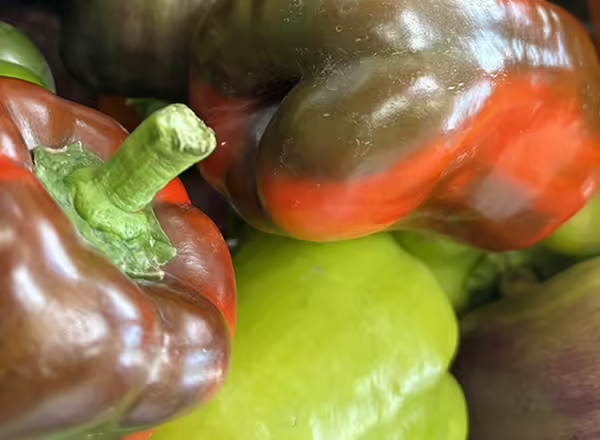
Troyer Family Gardens’ website says that the whole operation got its start when Cathy’s girls began selling excess sweet corn, over 25 years ago. That’s a far cry from the diversity they now offer over the span of the season. “How did you and your family learn to grow such great vegetables? Did anybody teach you when you were young? Or has it all been collective, iterative trial and error?”
“I grew up on a small family dairy farm near Streator, Illinois in LaSalle County,” Cathy shared. “We always had a garden when I was a kid, so when we got to this farm here, we started our garden area right away.” It got bigger as they had more kids, “and then yes, first growing just for ourselves, then selling sweetcorn, then adding more varieties of vegetables, there was a lot of trying things out and failing, lots of learning, and gradual improvement over the years.” They’ve now been at this “gardening” project for over 30 years. That’s a lot of wisdom and collective improvement.
Some of the best teachers are collective experience, determination, and detailed record-keeping.
The importance of record-keeping in vegetable production
I connected this question back to Cathy’s seed-ordering regimen. She keeps records of how every seed cultivar every purchased has performed. She notes germination dates, when it was potted up, transplant vigor rating, and more. We agreed that the importance of good records in vegetable production is hard to overstate.
“We have sewing and harvest dates, transplant dates, insect pressure, disease issues, what we fertilized with, what the customer response was like at market or farm store, sales, and more.”
With all that penciled out, it becomes a lot easier to determine whether to try this or that crop or variety again or move on to something else.
“If we try something at a certain scale and it doesn’t work out for whatever reason, or it doesn’t make sense, we’ll cut back or cut it out entirely,” Cathy shared.
A perfect example of this philosophy in action is their recent decision to downsize their green bean planting this year. Although everyone loves green beans to eat, nobody likes to pick them.
Cathy said it just didn’t make sense for them to keep doing any more on a large scale. “None of our grandkids want to pick them – so when they need picked, it’s slow going. We looked back at our records, and for the time needed to pick bean rows, compared to how many bags we had to sell at market, the math didn’t work.” They do offer some beans during the season, not much anymore.
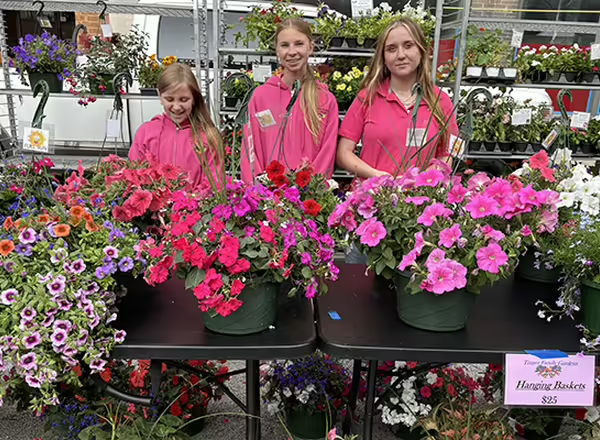
Although their “garden” project started out when the Troyer girls began selling their family’s excess sweetcorn, the core labor force at Troyer Family Gardens is now the next generation. Nine grandchildren in all provide Cathy with an amazing amount of high-quality labor on a weekly basis during the growing season. They may not be the world’s fastest green bean pickers, but they leave every other part of the business well-served, from customer interaction at market to harvest, washing, packing, weeding, trellising, and more.
Annette, Cathy’s oldest daughter, is a school nurse just like her mom was. She is the primary source of labor besides Cathy’s grandchildren. Annette enjoys taking the summer to work quietly by herself, and recharge for the school year.
“Tell me more about this. How does it work? How do you coordinate with all those family members what needs doing when, and how do you/they decide who will do what?” I asked.
“We use Signup Genius!” Cathy said. This was the first time I’d ever heard of a farm business utilizing this online software for farm labor management. “It’s great. Every Sunday, I send out a Signup Genius containing all the tasks that need doing for the week to the family group-chat (we’ve got a big one going…) – and everyone signs up for at least one 4-hour shift – usually more.” Some prefer working with customers – others prefer quietly harvesting. Everyone develops their niche, and for the most part, they complement each other.
Above all, this system builds in schedule flexibility. Some of the kids are in cross country, cheer, track and field, the list goes on – in both spring and fall. It also allows for more entrepreneurial grandchildren to jump on any open shifts and work more hours than the minimum, if desired. One of them just bought his first car, thanks in no small part to his long but well-paid hours spent working for the family business. “Sometimes we even have to tell them to cut back a bit and leave some shifts open for others!” Cathy shared.
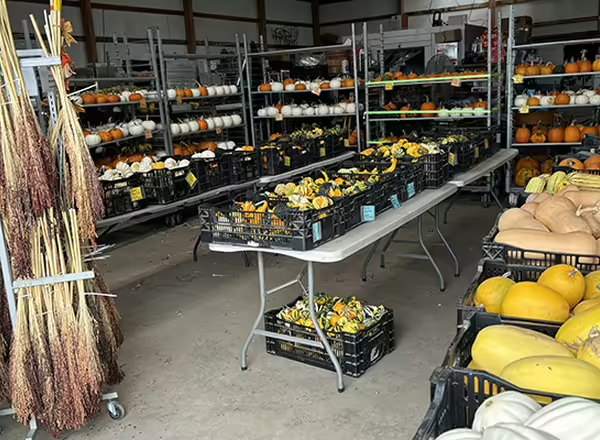
“That’s an impressive family crew you’ve got. But how do you keep everybody motivated through the long, hot days? And once the season is over, what about winter rest and recharging?” I asked.
“For a start,” Cathy said, “everyone that works here is very food motivated. Every so often, just because we can, I tell everyone to wrap up what they’re working on and jump in the van because we are going to Dairy Queen! That usually gets them moving…”
Cathy shared another great mid-season recharge protocol that struck me as incredibly healthy.
“In farming – it doesn’t matter what kind – it’s so easy to burn out, and for the farm to start to take too much from you.” I agreed and told her I was aware of several farmer friends that suffer from frequent seasonal burnout. “At our farm, we do our best to stay positive through the season by creating family fun time where the farm, farm business, etc. is not discussed at all. One Sunday a month, we’ll all get together and have a shrimp boil, a cookout, get the kids out on the ATVs, and just get together, have fun, and take a step back from everything.”
What happens when a lot of farm families get together – even for fun events – is that they end up talking shop, talking business. This can feel a lot like working even when you’re not working. “Yes,” said Cathy. “It’s an easy way to wreck a family – everyone ends up stressed out in the long haul,” Cathy shared. “So, we don’t do that!”
As far as recharging over the winter months, “the grandkids do a great job saving their money, and about every two years, we go to Mexico for a little while!” A couple years ago, Cathy and Larry took the whole family as a special treat. “All 17 of us went! And the grandkids loved it so much, they wanted to go again! I told them they had to each pay their own way – and now they do, with the money they make working here.”
As for Cathy and Larry, they still make time for doing things together every winter, just them. “We go to the Commodity Classic every year, and spend some time with one of my sisters who lives in Kansas City, MO. The Classic rotates throughout the country. It’s a fun event to attend, to learn what’s new in commodity farming, check out a new city, and spend time together.”
The Troyer Family Gardens crew gets it done all season long, giving the people what they want: fresh, beautiful vegetables – which is impressive enough. But I know a lot of farms that do that. What’s more impressive is how much they prioritize fun, family time, and recharging, while farming.
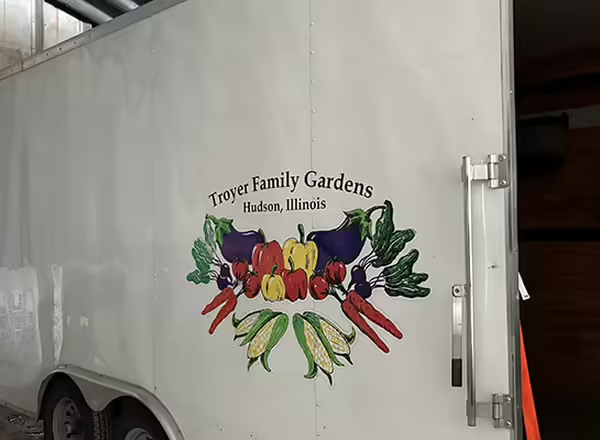
I returned to something that came up in the beginning of our conversation – namely, that Troyer Family Gardens is Cathy’s “retirement project”. “A lot of people I know talk about moving somewhere like Florida, spending time on the beach, golfing, fly-fishing, etc. “Why was vegetable farming the more attractive thing to you? What was your “why” that inspired you to pursue this, instead of kicking your feet up somewhere?”
In January 2013, Cathy’s retirement date of 2019 started to come into view. It had been more than 20 years of working as a school nurse and running the farm business on the side – even as it grew. “It was far off but it was in my mind. I had a conversation with Larry about his grain farming and the vegetable operation. I said we had to decide then and there. We were either going to stop everything when I retired, sell everything and move, or we would work to expand production capacity until I retired and make this (Troyer Family Gardens) the full-time family project.”
Larry had no immediate plans to retire from farming – “then or now!”, Cathy joked. “And it didn’t’ feel right – I didn’t want to stop either. We decided this is what we wanted to do. I was raised on a dairy farm; I was no stranger to daily work. So, the current business entity was formed in 2013, we added a bigger greenhouse, I retired in 2019, and we have expanded quite a bit.”
As the saying goes, you can take the farmer off the farm, but you can’t take farming out of the farmer.
As far as her “why”, Cathy shared a little bit more. “People must have a reason. People need to feel needed, and to have a purpose. For me, it’s our loyal customers and their appreciation and recognition for what we do. We have so many people that come out here and get sweet corn and other things – they can’t wait for the market once a week. Our customers recharge us. Getting to know them is such a treat.”
University of Illinois Extension Nutrition, Cooking, Preservation Classes Link Consumers to Farmers
I asked Cathy what she thought is some of the most valuable resources, workshops, or educational materials that we offer, and if there was anything we could do to help farmers like theirs succeed.
“I think the food preparation, preservation, and cooking classes Illinois Extension offers are highly valuable for people like us, because they allow our customers to learn how to cook and eat fresh produce. If they don’t know how to use cabbage, cauliflower, or beets, they probably won’t buy them.” She said they try to do a lot of that education themselves at the market booth and on the farm when selling the vegetables, “but, keep up the good work with what you guys are doing.”
Fall farm teamwork drives seasonality of produce at Troyer Family Gardens
I asked Cathy what the plans are for the rest of the year as summer winds down and fall comes into view. “Well, I drive the grain cart for Larry pretty much all harvest season every year, so we always grow many shelf-stable items that don’t need as much attention, and that match the season.” She shared that they grow pumpkins of all sizes, Indian corn, broom corn, and brussels sprouts. “We’re open 7 days a week in fall like we are in summer, 9AM to 6PM, except Sunday which is 11AM to 5PM.
“What’s some unsolicited but valuable advice that you would share with younger vegetable farmers just starting out in our tri-county area?” I asked. She had many great pearls of wisdom.
“That’s an easy one,” said Cathy. “My first advice is to enjoy the journey. If you’re not enjoying it, why are you doing that thing in the first place? Another big one would be to try and grow your business – but in a sustainable way. Don’t overwhelm yourself and your family. Have faith that if you try your best, God will provide. Be thankful for what you have. Expect some failures along the way and learn from them. Above all, make time to laugh and have fun.”
Retiring into purpose
I left Troyer Family Gardens mentally lighter than when I had arrived, and physically heavier – weighed down by a bag of sweet corn the size of Texas from their farm store. On my drive home, I thought about my own ideas of what my “retirement” would look like with my own family.
For Cathy, retirement isn’t about escape. It’s about digging deeper, growing stronger roots, and cultivating the next generation of farmers. In a world that often trades sweat equity for convenience and real connection for screen time, the Troyer Family Gardens team reminds us that there’s still something raw and real in hard work, good soil, and the reward of a well-earned Dairy Queen run. If you’re lucky, you don’t have to retire from purpose – you can retire into it.
